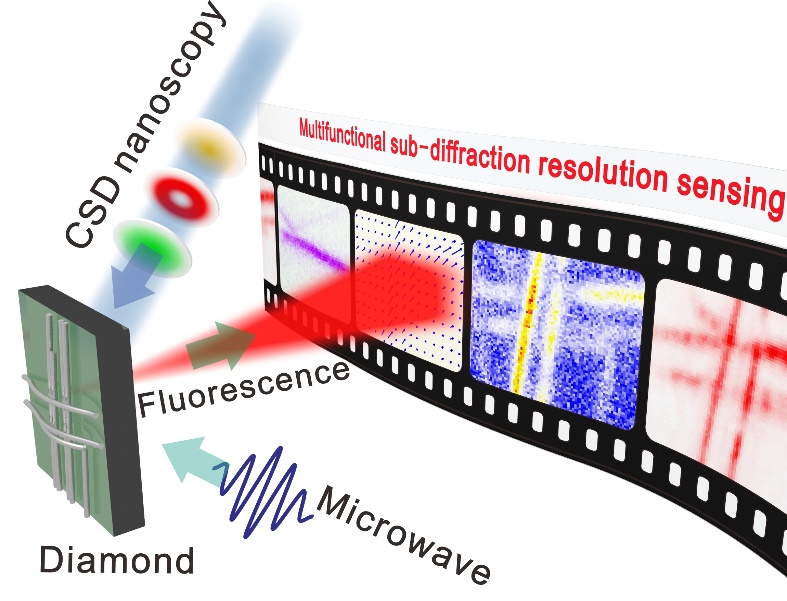[ Instrument Network Instrument Development ] Guo Guangcan, a member of the Chinese Academy of Sciences and a professor at the University of Science and Technology of China, made new progress in the research of practical quantum sensing. The team's Sun Fangwen group experiment realized 50 nm spatial resolution high-precision multi-function quantum sensing. The results of this series of research are published in the Physical Physics Applied Journal of Applied Physics.

Micro-nano optoelectronic technology has become one of the core technologies in the current information field, and also plays an important role in the fields of energy, environment and biomedicine. In general, micro-nano optoelectronic devices have the characteristics of small size, low electromagnetic field strength and vulnerability to interference. Therefore, the micro-nano electromagnetic field detection technology needs to solve the problems and challenges of high spatial resolution, high measurement sensitivity, and non-destructive measurement. Sun Fangwen's group focused on the challenges and difficulties of the above micro-nano electromagnetic field measurement, and proposed new techniques and methods such as quantum sensing and quantum probes to develop a new technology for far-field optical super-resolution imaging with nano-scale spatial resolution. Combined with the high fidelity metric sub-state control technology, the micro-nano electromagnetic field measurement technology with high spatial resolution, high measurement sensitivity and non-destructive measurement is realized.
Sun Fangwen's group first proposed and implemented Charge State Depletion Nano-Curve (CSD) with nano-scale spatial resolution ultra-low pump power based on the regulation of charge state in diamond nitrogen-vacancy color center. Imaging and detection of electron spin quantum states in nano-space resolution. The experimental resolution obtained by the experiment is 1/86 of the optical diffraction limit, which exceeds the accuracy of 1/67 obtained by STimulated Emission Depletion microscopy (STED, 2014 Nobel Prize in Chemistry). The pump power used is only 1/1000 of STED imaging and will be expected to be used in in vivo bioassays. The work was published in Phys. Rev. Appl. 7, 014008 (2017) and was selected as the current editorial recommendation paper. In addition, the researchers proposed time-gating techniques to improve the contrast of imaging signals and complete high-contrast quantum imaging. The work is published in Phys. Rev. Appl. 11, 064024 (2019). Furthermore, combining CSD nanoimaging with fluorescence lifetime imaging, optical polarization detection, and electron spin state high-fidelity metric manipulation techniques, the optical field density, polarization, and current carried by the metal nanowire structure are realized. Non-destructive measurement is performed on a plurality of physical quantities such as a generated magnetic field, and the spatial resolution is 50 nm. Because of the improved spatial resolution, the detection accuracy of the micro-nano photoelectric field exceeds 96%. This work is published in Phys. Rev. Appl. 12, 044039 (2019).
This series of work lays the foundation for high spatial resolution non-destructive electromagnetic field detection and practical quantum sensing. It will be applied to the detection of micro-nano electromagnetic fields and optoelectronic chips, as well as the interaction of micro-nano-scale electromagnetic fields with matter. In addition, this work broadens the application of far-field super-resolution imaging technology relative to high spatial resolution imaging of biomolecules.
The first author of the series was Chen Xiangdong, associate researcher at the Key Laboratory of Quantum Information, Chinese Academy of Sciences. The above research was supported by the Ministry of Science and Technology, the National Fund Committee, the Chinese Academy of Sciences and Anhui Province.
Thermocouple is an electrical device consisting of two different conductors forming electrical junctions at differing temperatures. A thermocouple produces a temperature-dependent voltage as a result of the thermoelectric effect, and this voltage can be interpreted to measure temperature. Thermocouples are a widely used type of temperature sensor.
Commercial thermocouples are inexpensive, interchangeable, are supplied with standard connectors, and can measure a wide range of temperatures. In contrast to most other methods of temperature measurement, thermocouples are self powered and require no external form of excitation. The main limitation with thermocouple is accuracy; system errors of less than one degree Celsius (℃) can be difficult to achieve.
Thermocouples are widely used in science and industry; applications include temperature measurement for kilns, gas turbine exhaust, diesel engines, and other industrial processes. Thermocouple are also used in homes, offices and businesses as the temperature sensors in thermostats, and also as flame sensors in safety devices for gas-powered major appliances.
Thermocouple
Gas Thermocouple,Thermocouple Price,Boiler Thermocouple,Gas Furnace Thermocouple
CHANGXING BENNENG GAS APPLIANCE CO.,LTD , https://www.benngas.com
